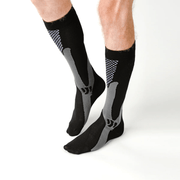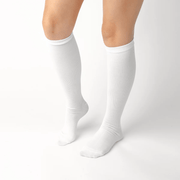During COVID-19, you have probably been not as active as usual. Sitting around watching movies and working online can lead to spending the best part of each day not moving. This is not good for you especially if there is poor blood flow to your lower legs and they are prone to swelling causing pain and discomfort.
Wearing compression socks can help get the blood moving and reduce the swelling. It is important to wear them when your doctor prescribes them for you. And if you have varicose veins, they may help you too.
Here are some tips to help you take care of yourself during COVID-19.
Put your compression socks on
There is no point not wearing your compression socks when your doctor prescribes them. If they hurt, then you probably need a bigger size.
Get in to the habit of putting your compression socks on as soon as you get out of bed every morning and take them off as you go to bed at night.
Go for a walk
Going for a walk may be difficult during lockdown but it is still possible. Try walk for a minimum of 30 minutes each day even if you break this down in to 10 minutes at a time. There is no need to walk briskly. Just go for a stroll. Enjoy your environment and your neighbour’s gardens. And if you are not allowed out, take a stroll around the house and garden a couple of times a day. It is a good opportunity to enjoy your garden.
Exercise your calf muscles
Exercise your calf muscles to reduce or prevent any swelling. Along with wearing your compression socks it can boost blood flow in the area. Try some of the following exercises to get your blood moving:
- Move your ankles in circles in one direction and then the other.
- Pretend you are driving the car and put each foot on a floor pedal several times.
- Do several standing heel and toe raises.
- March on the spot.
Rest feet above your heart
Elevating your feet above your heart is medically therapeutic. Lie on the couch and, with the help of pillows or cushions, raise your feet so they are above your heart. In other words, your toes should be at least at nose height or higher.
Look after your skin
Look after your skin as part of your overall leg health care strategy. Use a natural, good quality liquid soap when you wash daily. It will help stop your skin drying out. And at night, use a good moisturiser on your legs and feet before going to bed. This will give it a chance to absorb in to your skin overnight, and keep your skin moist and supple.
Organise your compression socks
Compression socks and stockings have an effective life of between three and six months. After this they will lost the ability to relieve welling or promote blood flow. So it is vital you know how long you have been wearing each pair. Find a way to mark each pair so you know when to stop wearing them.
When sitting around
When sitting around reading a book, watching a movie or checking out social media, exercise each leg. In between chapters or in ad or rest breaks try writing the alphabet with alternate big toes. Don’t laugh. Try it. It is harder than it sounds and gives your lower legs a good work out.
Rubber gloves can help
It can often be difficult to get compression socks on and off. Try wearing rubber gloves to help roll on or off your socks. This can make it easier. Often you just need the right techniques. When you know how to put them on and remove them the right way, you should never have problems again.
Take care of yourself
It is important to take of yourself during COVID-19. Make sure you are wearing your compression socks to help reduce pain and swelling in your lower legs. Go for a walk and spend time exercising your calf muscles when you spend a lot of time sitting around.
 Active Compression
Active Compression
 Plain Compression Socks
Plain Compression Socks

